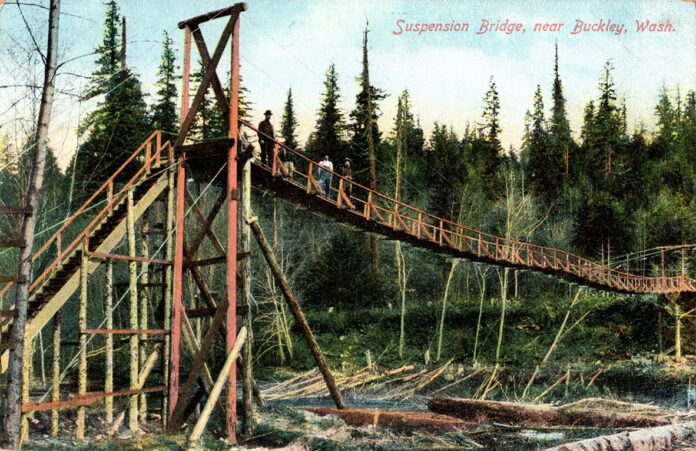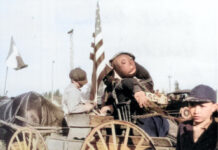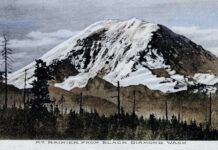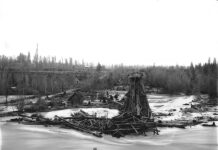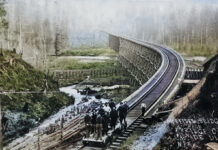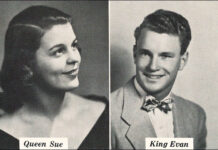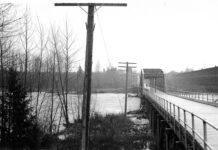South King County bridges are in the news, with both the Kummer Bridge, which crosses the Green River between Black Diamond and Enumclaw, and the White River Bridge, between Enumclaw and Buckley, closed to traffic. During an annual inspection of the S.R. 169 bridge over the Green River, cracking and advanced corrosion of stringers were discovered, frustrating the 11,000 vehicles that cross each day. The White River Bridge on State Route 410, which supports 22,000 daily crossings, has been closed since August 18, after a vactor truck ran into the framework, causing extensive damage to the seven horizontal and vertical bridge panels. The Kummer Bridge was completed in 1933, and the White River crossing in 1949.
Rivers have always presented challenges to humans. There are only four ways to cross: by fording, boat, bridge, or tunnel. A ford is a shallow place with good footing where people can cross a river or stream by wading or horseback. Many towns in the English-speaking world gained their name from fording, such as Oxford and Stratford-upon-Avon. Deeper water requires a raft, boat, or barge. As the crossing frequency increases, a bridge is the natural solution. Tunnels, such as the one under the English Channel, are exorbitantly expensive and reserved for exceptional circumstances.
The first crossings of the White River between Enumclaw and Buckley were accomplished by fording, primarily where Boise Creek flows into the White. However, crossing this glacial river was sometimes nearly impossible, and several drownings occurred. James and Marion Johnson, who came to the area from New Brunswick, Canada, in 1872, built a grist mill powered by the Boise Creek falls, but there wasn’t enough grain to grind. So, they abandoned the mill and started a rowboat ferry across the White River. Johnson and his sons operated the service, charging 25 cents per crossing. Travelers coming from Enumclaw stopped at the Johnson home to cross, and those coming from Buckley blew a horn or loudly hollered for service.
Even the Johnson family rowboat service was dangerous. On one occasion, James Johnson refused to cross because the river was too high, with logs and debris drifting downstream. Yet, two brothers, Tom and Jim Newlan, with their dogs, and Mr. Richards, a mail carrier, insisted on crossing over, promising to borrow Johnson’s boat and bring it back. A nervous dog caught the arm of the rower who lost an oar, and the boat careened into a log jam. Their three bodies were never found. The Johnson family operated the ferry service across the White River for eight years until the railroad bridge was built around 1885.
It is unclear when this suspension bridge for pedestrians was built or operated, but it was likely around 1905. This lithograph postcard was created from a photograph taken by Eric Skamser, who captured the railroad trestle that same year. Eric Skamser was a jeweler and businessman in Buckley. He rode a motorcycle in the early days and was an acquaintance of John Foseide, who had a Buckley studio specializing in stereo photography.
A second, black & white postcard photo shows the same suspension bridge with two cables, extending from both sides to hold up the center. This style of crossing is called a cable-stayed suspension bridge. It was believed to have washed away in a flood, as happened to the Northern Pacific Railway bridge, slightly further upstream, several times. A county highway bridge, upriver from the current structure undergoing repairs, was also lost to flooding.
This image from an unused postcard comes courtesy of JoAnne Matsumura, an Issaquah collector and historian. Norma Jean Contreas of the Foothills Historical Museum in Buckley provided additional information. Information about the Johnson family ferry service was found in the 1940 “Pioneer History of Enumclaw.” Steve Faulkner, a forest engineer who specializes in bridges, provided technical information. Next week, more about bridges over the White River.

